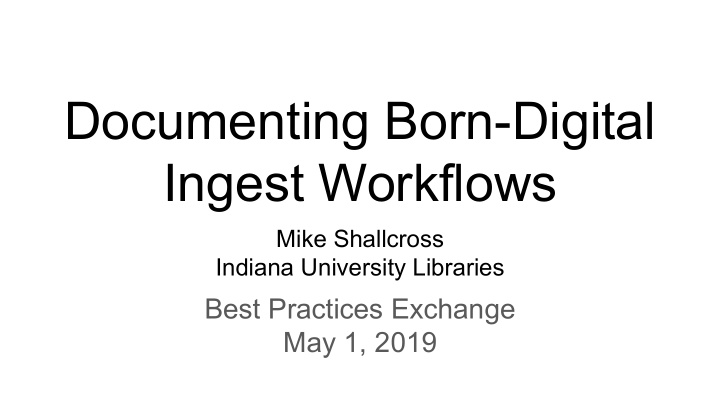



Documenting Born-Digital Ingest Workflows Mike Shallcross Indiana University Libraries Best Practices Exchange May 1, 2019
Indiana University & Born Digital Archives ● Extensive digital collections since early 90s (digitized AV, images, texts, TEI) ● Founding member of HathiTrust; Samvera partner ● Born Digital Archives ○ Custom projects: Virtual CD-ROM / Floppy Disk Library (ca. 2007-08) ○ Institutional repository (IUScholarWorks) ○ First digital preservation librarian: 2015-2017 ○ 2016 Digital Preservation Policy Framework Task Force: Digital Preservation Strategic Vision ○ Born Digital Preservation Lab: BitCurator and disk imaging
Ingest Goals ● Create standardized Submission Information Packages (SIPs) ● Reduce human errors/inconsistencies and increase overall efficiency. ● Facilitate content appraisal and identification of sensitive information before moving materials into longer-term storage. ● Capture information about preservation actions to ensure the authenticity and integrity of content.
Challenges ● Backlog ● Finding / retrieving legacy Submission Information Packages (SIPs) for collecting units ○ Lack of description ○ Disk images of 500 GB - 1 TB external hard drives ● Data management guidelines and storage of ‘critical’ data ● Limited IT support for BitCurator and programming
Opportunities and Considerations ● Digital forensics tools and strategies ● Metadata and format standards (esp. PREMIS and bagit) ● Opportunities for iterative improvements and interoperability ● Walsh, Sampson, Algana, Pendergrass (2018 BC Forum and forthcoming American Archivist article) ○ Emphasis on critical appraisal of content and capture procedures ● Ben Goldman (2016 PASIG and forthcoming SAA publication) ○ Authenticity and “meaningful metadata about the context and provenance of digital objects”
Brunnhilde (Tim Walsh) Influences Disk Image Processor (Tim Walsh) BitCurator Reports and PREMIS
Similar Projects: National Library of the Netherlands diskimgr omimgr tapeimgr
bdpl_ingest: General Approach ● Python; microservice design (includes key elements from Brunnhilde) ● Intended to facilitate the transfer and analysis of content in 4 main job types: ○ Disk images : use cases involving digital material stored on physical media, including 5.25" floppies, 3.5" floppies, zip disks, optical media, USB drives, and hard drives. ○ Copy only : use cases where disk imaging is not appropriate or where content has arrived via email, network transfer, or download. ○ DVD : use cases where moving image content is stored as DVD-Video on optical media. ○ CDDA : use cases where sound recordings are stored as Compact Disk Digital Audio on optical media. ● Collecting units: ○ Document media/individual transfers in a spreadsheet (include barcode, collection information, label transcription, notes for technician, etc.) ○ Appraisal decisions (with technical support as needed)
bdpl_ingest Interface
Transfer ● Disk imaging ○ ddrescue (production of raw images) ○ cdrdao (production of bin and cue files for CDDA use cases) ● File replication ○ tsk_rescue (file extraction from disk images with file systems that include ntfs, fat, exfat, hfs+, etc.) ○ unhfs (file extraction from disk images with file systems that include hfs and hfsx) ○ TeraCopy (replication of files in other use cases, including from optical media with ISO9660 or UDF file systems) ● Normalization ○ cdparanoia (production of single .wav and cue files for CDDA use cases) ○ ffmpeg (production of one .mpeg per title for DVD-Video use cases, with content information provided by lsdvd)
Analysis ● Virus scan ● Sensitive data scan: bulk_extractor ● Forensic feature analysis: ○ disktype (document disk image file system information) ○ fsstat (document range of metadata values and blocks/clusters) ○ ils (document allocated and unallocated inodes on the disk image) ○ mmls (document the layout of partitions on the disk image) ○ cdrdao disk-info (CDDAs) or lsdvd (DVD-Videos) ● Format identification: Siegfried ● Documentation of file directory structure: tree ● Checksum creation: fiwalk or md5deep (depending on use case) ● Scanned image(s) of physical media and packaging
Resulting Directory Structure (per barcode)
Documenting Ingest ● Log files ● Reports: ○ Siegfried format characterization ○ Brunnhilde HTML (and additional CSV reports generated from Siegfried output) ○ Tree output (directory structure ○ Reports specific to job type (i.e., cdrdao disk-info, lsdvd, The Sleuth Kit, etc.) ● Scanned images of media ● DFXML ● PREMIS ● Spreadsheet for review/appraisal ○ Descriptive/administrative metadata (from collecting unit) ○ Technical/preservation metadata (from ingest procedures)
PREMIS Event Information ● Create a dictionary of values upon completion of each microservice: ○ eventIdentifier ■ Type: UUID ■ Value from Python uuid module ○ eventType: PREMIS Preservation Events Controlled Vocabulary ○ eventDateTime: timestamp ○ eventDetail: command line arguments ○ eventOutcome: exit code returned by tool ○ eventOutcomeDetailNote: indication of successful/failed completion ○ linkingAgentIdentifier ■ Implementer: Indiana University Libraries ■ Executing software: software and version number ● Save each dictionary to a list and write to XML with Python lxml at conclusion
PREMIS Event Information <premis:event> <premis:eventIdentifier> <premis:eventIdentifierType>UUID</premis:eventIdentifierType> <premis:eventIdentifierValue>fb3fdde6-be4d-4eed-98e1-8057a84d9321</premis:eventIdentifierValue> </premis:eventIdentifier> <premis:eventType>disk image creation</premis:eventType> <premis:eventDateTime>2019-04-16 10:25:30.767206</premis:eventDateTime> <premis:eventDetailInformation> <premis:eventDetail>cdrdao read-cd --read-raw --session 1 --datafile X:\disk-image\UAC2017010081-01.bin --device 0,0,0 --driver generic-mmc-raw -v 1 X:\disk-image\UAC2017010081-01.toc</premis:eventDetail> </premis:eventDetailInformation> <premis:eventOutcomeInformation> <premis:eventOutcome>0</premis:eventOutcome> <premis:eventOutcomeDetail>
Spreadsheet report
Ongoing investigations... ● Additional documentation for: ○ Manual workarounds ○ Work performed by vendors (upcoming: data cartridges and tape) ● Appraisal process ○ Documenting separations/deaccessioning and redactions ○ Improving information in spreadsheet ● Potential workflow integration with: ○ ArchivesSpace (describe and track digital objects...and events?) ○ Digital preservation system (Archivematica? Preservica?) Feedback / suggestions: micshall@iu.edu https://github.com/IUBLibTech/bdpl_ingest
Recommend
More recommend